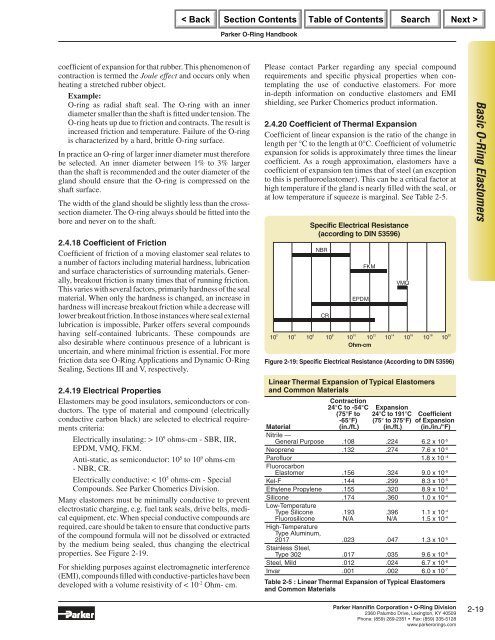Parker O-Ring Handbook.pdf
Parker O-Ring Handbook.pdf
Parker O-Ring Handbook.pdf
Create successful ePaper yourself
Turn your PDF publications into a flip-book with our unique Google optimized e-Paper software.
coeffi cient of expansion for that rubber. This phenomenon of<br />
contraction is termed the Joule effect and occurs only when<br />
heating a stretched rubber object.<br />
Example:<br />
O-ring as radial shaft seal. The O-ring with an inner<br />
diameter smaller than the shaft is fi tted under tension. The<br />
O-ring heats up due to friction and contracts. The result is<br />
increased friction and temperature. Failure of the O-ring<br />
is characterized by a hard, brittle O-ring surface.<br />
In practice an O-ring of larger inner diameter must therefore<br />
be selected. An inner diameter between 1% to 3% larger<br />
than the shaft is recommended and the outer diameter of the<br />
gland should ensure that the O-ring is compressed on the<br />
shaft surface.<br />
The width of the gland should be slightly less than the crosssection<br />
diameter. The O-ring always should be fi tted into the<br />
bore and never on to the shaft.<br />
2.4.18 Coeffi cient of Friction<br />
Coeffi cient of friction of a moving elastomer seal relates to<br />
a number of factors including material hardness, lubrication<br />
and surface characteristics of surrounding materials. Generally,<br />
breakout friction is many times that of running friction.<br />
This varies with several factors, primarily hardness of the seal<br />
material. When only the hardness is changed, an increase in<br />
hardness will increase breakout friction while a decrease will<br />
lower breakout friction. In those instances where seal external<br />
lubrication is impossible, <strong>Parker</strong> offers several compounds<br />
having self-contained lubricants. These compounds are<br />
also desirable where continuous presence of a lubricant is<br />
uncertain, and where minimal friction is essential. For more<br />
friction data see O-<strong>Ring</strong> Applications and Dynamic O-<strong>Ring</strong><br />
Sealing, Sections III and V, respectively.<br />
2.4.19 Electrical Properties<br />
Elastomers may be good insulators, semiconductors or conductors.<br />
The type of material and compound (electrically<br />
conductive carbon black) are selected to electrical requirements<br />
criteria:<br />
Electrically insulating: > 109 ohms-cm - SBR, IIR,<br />
EPDM, VMQ, FKM.<br />
Anti-static, as semiconductor: 105 to 109 ohms-cm<br />
- NBR, CR.<br />
Electrically conductive: < 105 ohms-cm - Special<br />
Compounds. See <strong>Parker</strong> Chomerics Division.<br />
Many elastomers must be minimally conductive to prevent<br />
electrostatic charging, e.g. fuel tank seals, drive belts, medical<br />
equipment, etc. When special conductive compounds are<br />
required, care should be taken to ensure that conductive parts<br />
of the compound formula will not be dissolved or extracted<br />
by the medium being sealed, thus changing the electrical<br />
properties. See Figure 2-19.<br />
For shielding purposes against electromagnetic interference<br />
(EMI), compounds fi lled with conductive-particles have been<br />
developed with a volume resistivity of < 10-2 Ohm- cm.<br />
<strong>Parker</strong> O-<strong>Ring</strong> <strong>Handbook</strong><br />
Please contact <strong>Parker</strong> regarding any special compound<br />
requirements and specifi c physical properties when contemplating<br />
the use of conductive elastomers. For more<br />
in-depth information on conductive elastomers and EMI<br />
shielding, see <strong>Parker</strong> Chomerics product information.<br />
2.4.20 Coeffi cient of Thermal Expansion<br />
Coeffi cient of linear expansion is the ratio of the change in<br />
length per °C to the length at 0°C. Coeffi cient of volumetric<br />
expansion for solids is approximately three times the linear<br />
coeffi cient. As a rough approximation, elastomers have a<br />
coeffi cient of expansion ten times that of steel (an exception<br />
to this is perfl uoroelastomer). This can be a critical factor at<br />
high temperature if the gland is nearly fi lled with the seal, or<br />
at low temperature if squeeze is marginal. See Table 2-5.<br />
10 2<br />
10 4<br />
Specific Electrical Resistance<br />
(according to DIN 53596)<br />
10 6<br />
NBR<br />
CR<br />
10 8<br />
10 10<br />
EPDM<br />
FKM<br />
VMQ<br />
Figure 2-19: Specifi c Electrical Resistance (According to DIN 53596)<br />
10 12<br />
Ohm-cm<br />
10 14<br />
10 16<br />
10 18<br />
Linear Thermal Expansion of Typical Elastomers<br />
and Common Materials<br />
Material<br />
Contraction<br />
24°C to -54°C<br />
(75°F to<br />
-65°F)<br />
(in./ft.)<br />
Expansion<br />
24°C to 191°C<br />
(75° to 375°F)<br />
(in./ft.)<br />
10 20<br />
Coeffi cient<br />
of Expansion<br />
(in./in./°F)<br />
Nitrile —<br />
General Purpose .108 .224 6.2 x 10 -5<br />
Neoprene .132 .274 7.6 x 10 -5<br />
Parofl uor 1.8 x 10 -4<br />
Fluorocarbon<br />
Elastomer .156 .324 9.0 x 10 -5<br />
Kel-F .144 .299 8.3 x 10 -5<br />
Ethylene Propylene .155 .320 8.9 x 10 -5<br />
Silicone .174 .360 1.0 x 10 -4<br />
Low-Temperature<br />
Type Silicone<br />
Fluorosilicone<br />
.193<br />
N/A<br />
.396<br />
N/A<br />
1.1 x 10 -4<br />
1.5 x 10 -4<br />
High-Temperature<br />
Type Aluminum,<br />
2017 .023 .047 1.3 x 10-5 Stainless Steel,<br />
Type 302 .017 .035 9.6 x 10-6 Steel, Mild .012 .024 6.7 x 10-6 Invar .001 .002 6.0 x 10-7 Table 2-5 : Linear Thermal Expansion of Typical Elastomers<br />
and Common Materials<br />
<strong>Parker</strong> Hannifi n Corporation • O-<strong>Ring</strong> Division<br />
2360 Palumbo Drive, Lexington, KY 40509<br />
Phone: (859) 269-2351 Fax: (859) 335-5128<br />
www.parkerorings.com<br />
Basic O-<strong>Ring</strong> Elastomers<br />
2-19

















